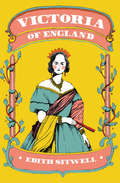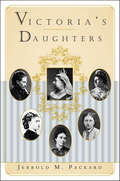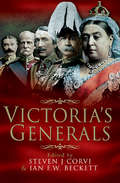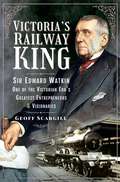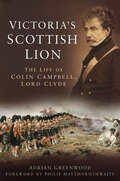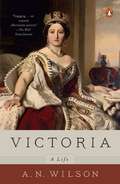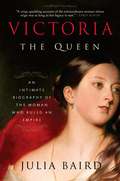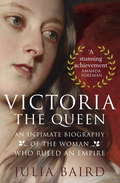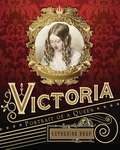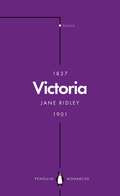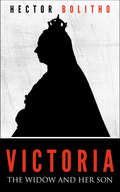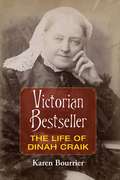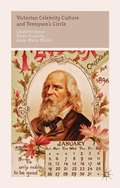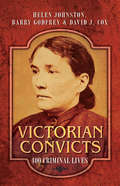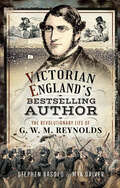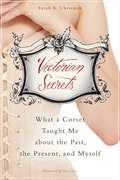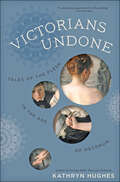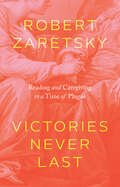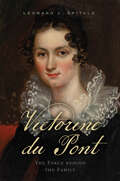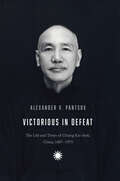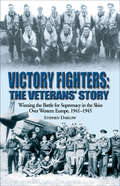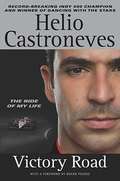- Table View
- List View
Victoria of England
by Edith SitwellA lively, opinionated biography of the queen, and a vivid portrait of nineteenth-century England, from a literary icon. ‘You call me the little Queen,’ she told her uncle the King of the Belgians; ‘my body is little, but my heart is not.’ Edith Sitwell’s endearing portrait of the young Victoria chronicles her unlikely ascension to the throne: spanning the succession crisis of King George III, her enduring love and marriage to Prince Albert, and her strength and power in a male-dominated world. Weaving in Victoria’s personal letters and diaries, Sitwell breathes life into the queen’s relationships with her family and her court. A rich exploration of Victoria’s reign and a social document of Victorian Britain, Victoria of England vividly illustrates the life of the iconic monarch with insight and emotion.
Victoria's Daughters
by Jerrold M. PackardThe story of five women who shared one of the most extraordinary and privileged sisterhoods of all time.Vicky, Alice, Helena, and Beatrice were historically unique sisters, born to a sovereign who ruled over a quarter of the earth's people and who gave her name to an era: Queen Victoria. Two of these princesses would themselves produce children of immense consequence. All five would curiously come to share many of the social restrictions and familial machinations borne by nineteenth-century women of less-exulted class.Victoria and Albert's precocious firstborn child, Vicky, wed a Prussian prince in a political match her high-minded father hoped would bring about a more liberal Anglo-German order. That vision met with disaster when Vicky's son Wilhelm-- to be known as Kaiser Wilhelm-- turned against both England and his mother, keeping her out of the public eye for the rest of her life. Gentle, quiet Alice had a happier marriage, one that produced Alexandra, later to become Tsarina of Russia, and yet another Victoria, whose union with a Battenberg prince was to found the present Mountbatten clan. However, she suffered from melancholia and died at age thirty-five of what appears to have been a deliberate, grief-fueled exposure to the diphtheria germs that had carried away her youngest daughter. Middle child Helena struggled against obesity and drug addition but was to have lasting effect as Albert's literary executor. By contrast, her glittering and at times scandalous sister Louise, the most beautiful of the five siblings, escaped the claustrophobic stodginess of the European royal courts by marrying a handsome Scottish commoner, who became governor general of Canada, and eventually settled into artistic salon life as a respected sculptor. And as the baby of the royal brood of nine, rebelling only briefly to forge a short-lived marriage, Beatrice lived under the thumb of her mother as a kind of personal secretary until the queen's death.Principally researched at the houses and palaces of its five subjects in London, Scotland, Berlin, Darmstadt, and Ottawa-- and entertainingly written by an experienced biographer whose last book concerned Victoria's final days-- Victoria's Daughters closely examines a generation of royal women who were dominated by their mother, married off as much for political advantage as for love, and finally passed over entirely with the accession of their n0 brother Bertie to the throne. Packard provides valuable insights into their complex, oft-tragic lives as daughters of their time.
Victoria's Generals
by Steven J Corvi Ian F.W BeckettThe senior British generals of the Victorian era - men like Wolseley, Roberts, Gordon and Kitchener - were heroes of their time. As soldiers, administrators and battlefield commanders they represented the empire at the height of its power. But they were a disparate, sometimes fractious group of men. They exhibited many of the failings as well as the strengths of the British army of the late nineteenth-century. And now, when the Victorian period is being looked at more critically than before, the moment is right to reassess them as individuals and as soldiers. This balanced and perceptive study of these eminent military men gives a fascinating insight into their careers, into the British army of their day and into a now-remote period when Britain was a world power.
Victoria's Railway King: Sir Edward Watkin, One of the Victorian Era’s Greatest Entrepreneurs and Visionaries
by Geoff ScargillThe accomplishments and initiatives, both social and economic, of Edward Watkin are almost too many to relate. Though generally known for his large-scale railway projects, becoming chairman of nine different British railway companies as well as developing railways in Canada, the USA, Greece, India and the Belgian Congo, he was also responsible for a stream of remarkable projects in the nineteenth century which helped shape people’s lives inside and outside Britain. As well as holding senior positions with the London and North Western Railway, the Worcester and Hereford Railway and the Manchester, Sheffield & Lincolnshire Railway, Watkin became president of the Grand Trunk Railway of Canada. He was also director of the New York, Lake Erie and Western Railways, as well as the Athens–Piraeus Railway. Watkin was also the driving force in the creation of the Manchester, Sheffield and Lincolnshire Railway’s ‘London Extension’ – the Great Central Main Line down to Marylebone in London. This, though, was only one part of his great ambition to have a high-speed rail link from Manchester to Paris and ultimately to India. This, of course, involved the construction of a Channel tunnel. Work on this began on both sides of the Channel in 1880 but had to be abandoned due to the fear of invasion from the Continent. He also purchased an area of Wembley Park, serviced by an extension of his Metropolitan Railway. He developed the park into a pleasure and events destination for urban Londoners, which later became the site of Wembley Stadium. It was also the site of another of Watkin’s enterprises, the ‘Great Tower in London’ which was designed to be higher than the Eiffel Tower but was never completed. Little, though, is known about Watkin’s personal life, which is explored here through the surviving diaries he kept. The author, who is the chair of The Watkin Society, which aims to promote Watkin’s life and achievements, has delved into the mind of one of the nineteenth century’s outstanding individuals.
Victoria's Scottish Lion: The Life of Colin Campbell, Lord Clyde
by Adrian Greenwood Philip J HaythornthwaiteFrom humble Glasgow beginnings, Colin Campbell rose to become Scotland’s finest general and a favourite of Queen Victoria. In his fifty-year career he fought through the Peninsula, the Crimea, China and India, and still found time to contain a slave revolt, a Chartist revolution and Ireland’s Tithe War. Through a combination of personal courage, compassionate leadership and genius for military strategy he became an idol for the men who served under him. This undisputed hero, whose memory has grown faint beside celebrated warriors of the Victorian age, was a soldier ahead of his time – the first working-class field marshal, with strong humanitarian leanings and an instinct for harnessing the power of the press. In the first major biography of Campbell since 1880 his career is radically reinterpreted and the life of this very private man is revealed. Victoria's Scottish Lion was shortlisted for The Society for Army Historical Research's 2015 Templar Prize.
Victoria: A Life
by A. N. Wilson"[A] shimmering and rather wonderful biography." --The Guardian (London)When Queen Victoria died in 1901, she had ruled for nearly sixty-four years. She was the mother of nine and grandmother of forty-two and the matriarch of royal Europe through her children's marriages. To many, Queen Victoria is a ruler shrouded in myth and mystique, an aging, stiff widow paraded as the figurehead to an all-male imperial enterprise. But in truth, Britain's longest-reigning monarch was one of the most passionate, expressive, humorous, and unconventional women who ever lived, and the story of her life continues to fascinate.A. N. Wilson's exhaustively researched and definitive biography includes a wealth of new material from previously unseen sources to show us Queen Victoria as she's never been seen before. Wilson explores the curious set of circumstances that led to Victoria's coronation, her strange and isolated childhood, her passionate marriage to Prince Albert and his pivotal influence even after death, and her widowhood and subsequent intimate friendship with her Highland servant John Brown, all set against the backdrop of this momentous epoch in Britain's history--and the world's.Born at the very moment of the expansion of British political and commercial power across the globe, Victoria went on to chart a unique course for her country even as she became the matriarch of nearly every great dynasty of Europe. Her destiny was thus interwoven with those of millions of people--not just in Europe but in the ever-expanding empire that Britain was becoming throughout the nineteenth century. The famed queen had a face that adorned postage stamps, banners, statues, and busts all over the known world.Wilson's Victoria is a towering achievement, a masterpiece of biography by a writer at the height of his powers.
Victoria: An Intimate Biography of the Woman Who Ruled an Empire
by Julia BairdThis page-turning biography reveals the real woman behind the myth: a bold, glamorous, unbreakable queen--a Victoria for our times. Drawing on previously unpublished papers, this stunning new portrait is a story of love and heartbreak, of devotion and grief, of strength and resilience. "A crisp, sparkling account of the extraordinary woman whose reign was as long as her legacy is vast."--Stacy Schiff When Victoria was born, in 1819, the world was a very different place. Revolution would threaten many of Europe's monarchies in the coming decades. In Britain, a generation of royals had indulged their whims at the public's expense, and republican sentiment was growing. The Industrial Revolution was transforming the landscape, and the British Empire was commanding ever larger tracts of the globe. In a world where women were often powerless, during a century roiling with change, Victoria went on to rule the most powerful country on earth with a decisive hand. Fifth in line to the throne at the time of her birth, Victoria was an ordinary woman thrust into an extraordinary role. As a girl, she defied her mother's meddling and an adviser's bullying, forging an iron will of her own. As a teenage queen, she eagerly grasped the crown and relished the freedom it brought her. At twenty, she fell passionately in love with Prince Albert of Saxe-Coburg and Gotha, eventually giving birth to nine children. She loved sex and delighted in power. She was outspoken with her ministers, overstepping conventional boundaries and asserting her opinions. After the death of her adored Albert, she began a controversial, intimate relationship with her servant John Brown. She survived eight assassination attempts over the course of her lifetime. And as science, technology, and democracy were dramatically reshaping the world, Victoria was a symbol of steadfastness and security--queen of a quarter of the world's population at the height of the British Empire's reach. Drawing on sources that include fresh revelations about Victoria's relationship with John Brown, Julia Baird brings vividly to life the fascinating story of a woman who struggled with so many of the things we do today: balancing work and family, raising children, navigating marital strife, losing parents, combating anxiety and self-doubt, finding an identity, searching for meaning. Advance praise for Victoria: The Queen "Victoria was young enough when she assumed the throne to consult with her prime minister about her eyebrows (were they too thin?), confident enough when she married to elect to preserve the word 'obey' in her vows. Julia Baird vividly captures her in every light, at once bold and sentimental, stubborn and deferential."--Stacy Schiff "A stunning achievement . . . Neither sanitized nor mythologizing, Victoria: The Queen is a remarkably lucid, endlessly engaging account of Queen Victoria's life and rule."--Amanda Foreman "With elegance and keen insight, Julia Baird has painted a memorable, moving, and surprising portrait of one of the most important women in history. This is a remarkable book; in Baird's hands, Victoria's story resonates in our own time, shedding new light on why we live the way we do now."--Jon Meacham
Victoria: An Intimate Biography of the Woman who Ruled an Empire
by Julia BairdNAMED ONE OF THE BEST BOOKS OF THE YEAR BY JANET MASLIN, THE NEW YORK TIMES'Victoria the Queen, Julia Baird's exquisitely wrought and meticulously researched biography, brushes the dusty myth off this extraordinary monarch' The New York Times Book Review (Editor's Choice).The true story for fans of the hit ITV drama series Victoria starring Jenna Coleman, this page-turning biography reveals the real woman behind the myth: a bold, glamorous, unbreakable queen. Drawing on previously unpublished papers, this stunning book is a story of love and heartbreak, of devotion and grief, of strength and resilience.When Victoria was born, in 1819, the world was a very different place. Revolution would begin to threaten many of Europe's monarchies in the coming decades. In Britain, a generation of royals had indulged their whims at the public's expense, and republican sentiment was growing. The Industrial Revolution was transforming the landscape, and the British Empire was commanding ever larger parts of the globe. Born into a world where woman were often powerless, during a century roiling with change, Victoria went on to rule the most powerful country on earth with a decisive hand.Fifth in line to the throne at the time of her birth, Victoria was an ordinary woman thrust into an extraordinary role. As a girl, she defied her mother's meddling and an adviser's bullying, forging an iron will of her own. As a teenage queen, she eagerly grasped the crown and relished the freedom it brought her. At twenty years old, she fell passionately in love with Prince Albert of Saxe-Coburg and Gotha, eventually giving birth to nine children. She loved sex and delighted in power. She was outspoken with her ministers, overstepping boundaries and asserting her opinions. After the death of her adored Albert, she began a controversial, intimate relationship with her servant John Brown. She survived eight assassination attempts over the course of her lifetime. And as science, technology, and democracy were dramatically reshaping the world, Victoria was a symbol of steadfastness and security-queen of a quarter of the world's population at the height of the British Empire's reach.Drawing on sources that include revelations about Victoria's relationship with John Brown, Julia Baird brings vividly to life the fascinating story of a woman who struggled with so many of the things we do today: balancing work and family, raising children, navigating marital strife, losing parents, combating anxiety and self-doubt, finding an identity, searching for meaning. This sweeping, page-turning biography gives us the real woman behind the myth.
Victoria: Portrait of a Queen
by Catherine ReefCatherine Reef brings history vividly to life in this sumptuously illustrated account of a confident, strong-minded, and influential woman. Victoria woke one morning at the age of eighteen to discover that her uncle had died and she was now queen. She went on to rule for sixty-three years, with an influence so far-reaching that the decades of her reign now bear her name—the Victorian period. Victoria is filled with the exciting comings and goings of royal life: intrigue and innuendo, scheming advisors, and assassination attempts, not to mention plenty of passion and discord. Includes bibliography, notes, British royal family tree, index.
Victoria: Queen, Matriarch, Empress (Penguin Monarchs)
by Jane RidleyPart of the Penguin Monarchs series: short, fresh, expert accounts of England's rulers in a collectible formatQueen Victoria inherited the throne at 18 and went on to become the longest-reigning female monarch in history, in a time of intense industrial, cultural, political, scientific and military change within the United Kingdom and great imperial expansion outside of it (she was made Empress of India in 1876). Overturning the established picture of the dour old lady, this is a fresh and engaging portrait from one of our most talented royal biographers.Jane Ridley is Professor of Modern History at Buckingham University, where she teaches a course on biography. Her previous books include The Young Disraeli; a study of Edwin Lutyens, The Architect and his Wife, which won the 2003 Duff Cooper Prize; and the best-selling Bertie: A Life of Edward VII. A Fellow of the Royal Society for Literature, Ridley writes for the Spectator and other newspapers, and has appeared on radio and several television documentaries. She lives in London and Scotland.
Victoria: The Widow and Her Son
by Hector BolithoThe author of the “monumental, scholarly study” The Reign of Queen Victoria delves into her unique relationship with her son Edward during her final years (Kirkus Reviews). In this biography, Hector Bolitho paints a fascinating portrait of the life of the two monarchs, focusing on how their contentious relationship evolved after the death of Victoria’s beloved Prince Consort. Victoria and Edward are here given equal attention, with their often-conflicting perspectives presented without bias or retrospective judgement. Bolitho begins the narrative in 1861 with the death of Albert and Queen Victoria’s inconsolable grief at the loss of her love. As Victoria’s mourning begins to impact her rule, young Edward is torn between his youthful, pleasure-seeking nature and his duties as heir to the throne. In this authoritative and insightful biography, Bolitho illustrates the latter part of Victoria’s rule, highlighting the tumultuous relationship between a grieving widow and her unruly son. Under Bolitho’s sympathetic eye, these two giants of British history are, finally, rendered human.
Victorian Bestseller: The Life of Dinah Craik
by Karen BourrierWhen novelist Dinah Craik (1826–87) died, expressions of grief came from Lord Alfred Tennyson, Matthew Arnold, Robert Browning, T.H. Huxley, and James Russell Lowell, among others, and even Queen Victoria picked up her pen to offer her consolation to the widower. Despite Craik’s enormous popularity throughout a literary career that spanned forty years, she is now all but forgotten. Yet, in an otherwise respectable life bookended by scandal, this was precisely the way that she wanted it. Victorian Bestseller is the first book to relate the story of Dinah Craik’s remarkable life. Combining extensive archival work with theoretical work in disability studies and the professionalization of women’s authorship, Karen Bourrier engagingly traces the contours of this author’s life. Craik, who wrote extensively about disability in her work, was no stranger to it in her personal and professional life, marked by experiences of mental and physical disability, and the ebb and flow of health. Following scholarship in the ethics of care and disability studies, the book posits Craik as an interdependent subject, placing her within a network of writers, publishers, editors and artists, friends, and family members. Victorian Bestseller also traces the conditions in the material history of the book that allowed Victorian women writers’ careers to flourish. In doing so, the biography connects corporeality, gender, and the material history of the book to the professionalization of Victorian women’s authorship.
Victorian Celebrity Culture and Tennyson’s Circle
by Charlotte Boyce Páraic Finnerty Anne-Marie MillimTennyson experienced at first hand the all-pervasive nature of celebrity culture. It caused him to retreat from the eyes of the world. This book delineates Tennyson's reluctant celebrity and its effects on his writings, on his coterie of famous and notable friends and on the ever-expanding, media-led circle of Tennyson's admirers.
Victorian Convicts: 100 Criminal Lives
by Barry Godfrey David J. Cox Helen Johnston&“An interesting introduction to Victorian crimes, the people who committed them, and how effective rehabilitation may have been.&” —Ripperologist Magazine What was life like in the Victorian underworld—who were the criminals, what crimes did they commit, how did they come to a criminal career, and what happened to them after they were released from prison? Victorian Convicts, by telling the stories of a hundred criminal men and women, gives the reader an insight into their families and social background, the conditions in which they lived, their relationships and working lives, and their offences. They reveal how these individuals were treated by the justice and penal system of 150 years ago, and how they were regarded by the wider world around them. Such a rare and authentic insight into life in and out of prison will be fascinating reading for anyone who is interested in the history of crime and criminals, in legal and prison history and in British society in the nineteenth century. &“A fascinating, informative and educational read providing the history of these one hundred individuals who lived so long ago but who can teach us today the practices of the Victorian penal system and the struggles of the era.&” —Crime Traveller &“It is intriguing and very readable opening a window into lives of so many unfortunates. If you have an interest in police history this work, particularly details of numerous convictions and what followed after the court case was concluded, will be of interest.&” —Surrey Constabulary History Journal
Victorian England's Bestselling Author: The Revolutionary Life of G. W. M. Reynolds
by Stephen Basdeo Mya DriverGeorge W.M. Reynolds (1814–79) was one of the biggest-selling novelists of the Victorian era. He was the author of over 58 novels and short stories and his “penny blood” The Mysteries of London, serialised in weekly numbers between 1844 and 1848, sold over a million copies. A controversial figure in his lifetime, Reynolds’s Mysteries, and its follow-up The Mysteries of the Court of London (1849–56), contained tales of crime, vice, and highly sexualised scenes. For this reason Charles Dickens remarked that Reynolds’s name was one “with which no lady’s, and no gentleman’s, should be associated.” Yet Reynolds was much more than just a novelist; he was lauded by the working classes as their champion and campaigned for universal suffrage. To further the working classes’ cause, he established two newspapers: Reynolds’s Political Instructor and Reynolds’s Weekly Newspaper. The latter newspaper, as Karl Marx recognized, became the principal organ of radical and labour politics. This book provides a biography of Reynolds and reproduces his editorials from Reynolds’s Political Instructor as well as excerpts from his fiction.
Victorian Secrets: What a Corset Taught Me about the Past, the Present, and Myself
by Sarah A. Chrisman Sue LeanOn Sarah A. Chrisman’s twenty-ninth birthday, her husband, Gabriel, presented her with a corset. The material and the design were breathtakingly beautiful, but her mind immediately filled with unwelcome views. Although she had been in love with the Victorian era all her life, she had specifically asked her husband not to buy her a corset?ever. She’d heard how corsets affected the female body and what they represented, and she wanted none of it. However, Chrisman agreed to try on the garment . . . and found it surprisingly enjoyable. The corset, she realized, was a tool of empowerment?not oppression. After a year of wearing a corset on a daily basis, her waist had gone from thirty-two inches to twenty-two inches, she was experiencing fewer migraines, and her posture improved. She had successfully transformed her body, her dress, and her lifestyle into that of a Victorian woman?and everyone was asking about it. In Victorian Secrets, Chrisman explains how a garment from the past led to a change in not only the way she viewed herself, but also the ways she understood the major differences between the cultures of twenty-first-century and nineteenth-century America. The desire to delve further into the Victorian lifestyle provided Chrisman with new insight into issues of body image and how women, past and present, have seen and continue to see themselves.
Victorians (EDGE: Mad, Bad and Just Plain Dangerous #3)
by John TownsendTime to take a sideways look at the bizarre and outrageous from throughout history - and it's all TRUE!Which new material got the Victorians building mad?Who was the bad guy that committed terrible crimes in London?Which dangerous job was banned for boys under 10?Find out the answers to these questions inside, along with lots of facts, quizzes, and other bonkers stuff as you take a bumpy journey into the darkest crannies of Victorian history with Mad, Bad and Just Plain Dangerous!
Victorians Undone: Tales of the Flesh in the Age of Decorum
by Kathryn HughesA fascinating account of what it was like to live in a Victorian body from best-selling historian and critic Kathryn Hughes.In Victorians Undone, renowned British historian Kathryn Hughes follows five iconic figures of the nineteenth century as they encounter the world not through their imaginations or intellects but through their bodies. Or rather, through their body parts. Using the vivid language of admiring glances, cruel sniggers, and implacably turned backs, Hughes crafts a narrative of cinematic quality by combining a series of truly eye-opening and deeply intelligent accounts of life in Victorian England.Lady Flora Hastings is an unmarried lady-in-waiting at young Queen Victoria's court whose swollen stomach ignites a scandal that almost brings the new reign crashing down. Darwin's iconic beard provides important new clues to the roles that men and women play in the great dance of natural selection. George Eliot brags that her right hand is larger than her left, but her descendants are strangely desperate to keep the information secret. The poet-painter Dante Gabriel Rossetti, meanwhile, takes his art and his personal life in a new direction thanks to the bee-stung lips of his secret mistress, Fanny Cornforth. Finally, we meet Fanny Adams, an eight-year-old working-class girl whose tragic evisceration tells us much about the currents of desire and violence at large in the mid-Victorian countryside. While 'bio-graphy' parses as 'the writing of a life,' the genre itself has often seemed willfully indifferent to the vital signs of that life—to breath, movement, touch, and taste. Nowhere is this truer than when writing about the Victorians, who often figure in their own life stories as curiously disembodied. In lively, accessible prose, Victorians Undone fills the space where the body ought to be, proposing new ways of thinking and writing about flesh in the nineteenth century.
Victories Never Last: Reading and Caregiving in a Time of Plague
by Robert ZaretskyA timely and nuanced book that sets the author’s experience as a nursing home volunteer during the pandemic alongside the wisdom of great thinkers who confronted their own plagues. In any time of disruption or grief, many of us seek guidance in the work of great writers who endured similar circumstances. During the first year of the COVID-19 pandemic, historian and biographer Robert Zaretsky did the same while also working as a volunteer in a nursing home in south Texas. In Victories Never Last Zaretsky weaves his reflections on the pandemic siege of his nursing home with the testimony of six writers on their own times of plague: Thucydides, Marcus Aurelius, Michel de Montaigne, Daniel Defoe, Mary Shelley, and Albert Camus, whose novel The Plague provides the title of this book. Zaretsky delves into these writers to uncover lessons that can provide deeper insight into our pandemic era. At the same time, he goes beyond the literature to invoke his own experience of the tragedy that enveloped his Texas nursing home, one which first took the form of chronic loneliness and then, inevitably, the deaths of many residents whom we come to know through Zaretsky’s stories. In doing so, Zaretsky shows the power of great literature to connect directly to one’s own life in a different moment and time. For all of us still struggling to comprehend this pandemic and its toll, Zaretsky serves as a thoughtful and down-to-earth guide to the many ways we can come to know and make peace with human suffering.
Victories Never Last: Reading and Caregiving in a Time of Plague
by Robert ZaretskyA timely and nuanced book that sets the author’s experience as a nursing home volunteer during the pandemic alongside the wisdom of great thinkers who confronted their own plagues. In any time of disruption or grief, many of us seek guidance in the work of great writers who endured similar circumstances. During the first year of the COVID-19 pandemic, historian and biographer Robert Zaretsky did the same while also working as a volunteer in a nursing home in south Texas. In Victories Never Last Zaretsky weaves his reflections on the pandemic siege of his nursing home with the testimony of six writers on their own times of plague: Thucydides, Marcus Aurelius, Michel de Montaigne, Daniel Defoe, Mary Shelley, and Albert Camus, whose novel The Plague provides the title of this book. Zaretsky delves into these writers to uncover lessons that can provide deeper insight into our pandemic era. At the same time, he goes beyond the literature to invoke his own experience of the tragedy that enveloped his Texas nursing home, one which first took the form of chronic loneliness and then, inevitably, the deaths of many residents whom we come to know through Zaretsky’s stories. In doing so, Zaretsky shows the power of great literature to connect directly to one’s own life in a different moment and time. For all of us still struggling to comprehend this pandemic and its toll, Zaretsky serves as a thoughtful and down-to-earth guide to the many ways we can come to know and make peace with human suffering.
Victorine du Pont: The Force behind the Family (Cultural Studies of Delaware and the Eastern Shore)
by Leonard C. SpitaleVictorine Elizabeth du Pont, the first child of Eleuthère Irénée du Pont and his wife Sophie, was seven years old when her family emigrated to America, where her father established the humble beginnings of what would become a corporate giant. Through correspondence with friends and relatives from the ages of eight to sixty-eight, Victorine unwittingly chronicled the first sixty years of the du Pont saga in America. As she recovered from personal tragedy, she became first tutor of her siblings and relations. This biography makes the case that Victorine has had the broadest—and most enduring—influence within the entire du Pont family of any family member. The intellectual heir of her venerable grandfather, Pierre Samuel du Pont de Nemours, although Victorine grew up in an age where women's opportunities were limited, her pioneering efforts in education, medicine, and religion transformed an entire millworkers’ community.
Victorious in Defeat: The Life and Times of Chiang Kai-shek, China, 1887-1975
by Alexander V. PantsovAn extensively researched, comprehensive biography of Chinese Nationalist leader Chiang Kai-shek, one of the twentieth century&’s most powerful and controversial figures Chiang Kai-shek (1887–1975) led the Republic of China for almost fifty years, starting in 1926. He was the architect of a new, republican China, a hero of the Second World War, and a faithful ally of the United States. Simultaneously a Christian and a Confucian, Chiang dreamed of universal equality yet was a perfidious and cunning dictator responsible for the deaths of over 1.5 million innocent people. This critical biography is based on Chiang Kai-shek&’s unpublished diaries, his extensive personal files from the Russian archives, and the Russian files of his relatives, associates, and foes. Alexander V. Pantsov sheds new light on the role played by the Russians in Chiang&’s rise to power in the 1920s and throughout his political career—and indeed the Russian influence on the Chinese revolutionary movement as a whole—as well as on Chiang&’s complex relationship with top officials of the United States. It is a detailed portrait of a man who ranks with Stalin, Roosevelt, Hitler, Churchill, and Gandhi as leaders who shaped our world.
Victory Fighters: Winning the Battle for Supremacy in the Skies Over Western Europe, 1941–1945
by Stephen DarlowA collection of eyewitness accounts of the struggle that raged in the skies over occupied Europe after the Battle of Britain during World War II. Expertly selected and interwoven by Stephen Darlow, Victory Fighters centers on the stories of six pilots and one navigator, the telling of which covers every aspect of this battle over land and sea. The author describes and analyzes the relevant command decisions from the highest level down, and against this background the men give their accounts from the start of their flying careers through to the preparations for operation Overlord, the invasion itself, the liberation of France, the crossing of the Rhine, to the end of the war in Europe on VE-Day. Through their eyes, the reader is introduced to a series of different tasks and situations, a multitude of aircraft types—Sunderlands, Mustangs, Tempests, Typhoons, Spitfires, Whirlwinds, Mosquitoes—and a great many squadrons. Having conducted numerous interviews and undertaken diligent research of documents, diaries and correspondence, the author has produced a fitting testament to these men and the countless others they represent.
Victory Over Trials: Encouragement From the Life of Job
by Lottie B. Hobbs[from the back page] If you have ever experienced discouragement, disappointment, pain, grief, doubt, or any other heartache, this book is for you. The author gleans enlightenment, strength, and direction from the most magnificent and soul-stirring drama of all time: the Book of Job. Job - an emotionally torn, suffering, grieving man - grappled with life's heaviest burdens and most perplexing questions. He triumphed! So can we! Victory Over Trials is not a tedious analysis. It is easily understood, up-to-date, and practical. Ideal for individual and class use. One reader concludes: "Each chapter is worth the price of the book." LOTTIE BETH HOBBS is acclaimed in international journals in the U.S. and Europe as a writer, speaker, and editor. Some of her books have had more than twenty printings in English and are still in demand. Some have been published in Spanish, French, Portuguese, and several languages of India. Many of her popular pamphlets, on a wide variety of topics, are distributed internationally.
Victory Road
by Roger Penske Helio CastronevesThe Indianapolis 500 champion and winner of season five's Dancing with the Stars shares his heartfelt story about determination, family, justice, and beating all odds to win. With his signature victory celebration of climbing the fence after taking the checkered flag and his radiant performances that earned him the coveted crystal ball trophy on Dancing with the Stars, Helio's infectious enthusiasm garnered the admiration of millions of fans-both on and off the track. Therefore no one, including him, could have predicted that one day he would sit in a federal court along with his sister/manager facing 10 years in jail. After his grueling trial-where justice prevailed and charges were dropped-Helio learned more than ever before about his family, true friends, faith, and the road to victory. In this book, Helio Castroneves tells his resilient story about his greatest accomplishments, most devastating experiences, becoming a father, and valuing what is truly important in life.
